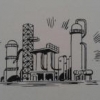Hai Mr Pilesar and Mr Art Montemayor.
I am sorry that i didn't properly describe the situation and my role.
I represent the owner of the project as an engineer. The detailed engineering documents were created by Consultant and had been reviewed (and approved) by our other division (division A) before being transferred to my division (division B ) for further process (procurement and construction). Unfortunately there was a organizational restructurization and most of the staffs (from division A) who handled the previous process (detailed engineering) were transferred somewhere else.
Now after continuing the process to procurement and construction, the Contractor finds several inconsistency and after contract award they ask for clarification from my division (division B ) before proposing additional cost. My division (division B ) doesn't want to be held responsible for this additional cost and thus ask division A to clarify, but it takes really long time to clarify (they said the documents have been approved, the contract with the Consultant has been settled and they need to pay additional cost to get clarification from the Consultant, etc).
What is the normal practice if after contract closing, the owner finds out that the some of the Consultant's deliverable is incorrect? Should the owner ask the Consultant to fix the deliverable without paying additional cost or is it normal to pay additional cost to fix it?
The additional cost probably relatively low, but right now the cumulative change order has already exceeded our normal tolerance (due to other incomplete/missing scope, etc), and we're already behind the schedule, so my boss ask my division to try fixing it internally together with division A (without Consultant who created those documents).
Edited by Skyline, 16 May 2018 - 01:22 AM.

 FB
FB











